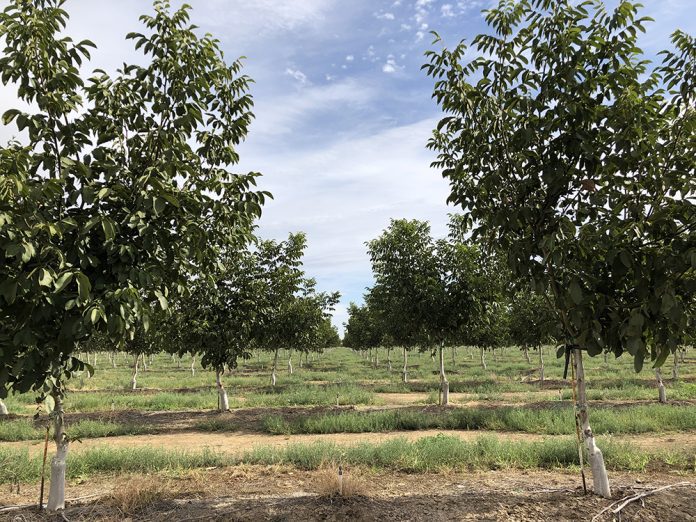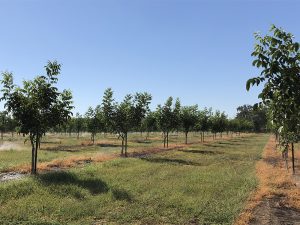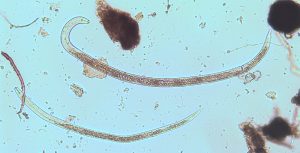
Managing root lesion nematode, Pratylenchus vulnus, the primary plant-parasitic nematode in walnut production, is expected to become more difficult with California Department of Pesticide Regulation’s (CDPR) new restrictions on the use of Telone proposed to begin January 2024.
The economic threshold for root lesion nematode on walnut is 1 per 250 cm3 of soil. Eliminating this nematode as much as possible prior to planting walnuts is critical for the long-term health of orchards. The fumigant Telone, 1,3-D, often used in blends with chloropicrin, is currently the only product that is effective against root lesion nematode and there are no commercially available effective alternatives at this time.
“There are some promising treatments against root lesion nematode, but they are not yet registered, have technical limitations and may be cost prohibitive,” Andreas Westphal, UC Riverside nematologist, said.
According to The Walnut Scion and Rootstock Improvement Working Group, root lesion nematode, Pratylenchus vulnus, is parasitic on most perennial crops. Surveys showed that root lesion nematode infests 85% of California walnut acreage. Its direct impact on walnut roots can be debilitating. Symptoms include root lesions, root loss and halted tree growth. Infestations of root lesion nematode in walnut orchards rarely kills mature trees but can severely stunt tree growth, and even at sublethal populations may reduce yields. Root lesion nematode reproduces rapidly. Within a single season, starting from small initial populations, Pratylenchus vulnus can reach damage thresholds and, within two years, can result in a 20% reduction of tree growth. Root damage induced by P. vulnus can result in fewer and smaller nuts, limb dieback in trees of bearing age and root stunting in replant sites can destroy young trees.
Increased soil moisture levels for Telone use as part of the proposed CDPR rules are expected to make Telone less effective. In addition, the proposed requirement for deeper injection of Telone for perennial crops presents technical and logistical challenges including a need for larger tractors and/or greater fuel consumption to pull application shanks at the proposed deeper soil depth. Westphal confirmed the higher moisture requirements are likely to slow fumigant movement in soil, thus potentially reducing treatment efficacy.
Replacing 2017 Permit Conditions
CDPR’s proposed regulation would replace the 2017 recommended permit conditions for 1,3-D and address all potential exposure periods: acute, seasonal and sub-chronic, annual and lifetime. The proposal would also eliminate the existing 1,3-D township cap regulatory system and replace it with more restrictive and new conditions for 1,3-D applications.
On February 2, 2023, DPR informed CDFA of several changes in the first version of the proposed fumigant regulation from June 2022. The revisions included more fumigant application rate increments in the setback tables and a more complete set of setback distances to occupied structures (100, 200, 300, 400 and 500 ft), and added two “regions”, inland and costal, each with its own set of setback distances for the different application methods of Telone.
In general, the higher the application rate and shorter the distance to an occupied structure, the lower the maximum application block size for each application method. The maximum permitted block size can range from 0 acres (application not permitted) to as much as 80 acres for some application methods and rates. For untarped applications, including deep injection for perennial crops, growers and applicators will need to choose between large setbacks (100 to 500 ft if the site can accommodate such distances) or much smaller individual application block sizes than were treatable in prior years. For example, growers used to treating a 30- to 40-acre block in one day may now be faced with needing to break this field up into three to five smaller application blocks done over many days.
In a 2023 presentation by Shawn Fields of TriCal Inc., he notes that Cal-EPA’s interpretation of 1,3-D toxicity studies and exposure risk assessments are very different from those of U.S. EPA. The California agency assumes a person does not leave their immediate location for 70 years and is continuously exposed. Overall, Cal-EPA’s toxicological endpoint selections are about 40-fold more conservative than U.S. EPA’s endpoints for the same exposure duration.
In addition to the higher soil moisture and deeper injection requirements, there are increased setback distances, application block limits and seasonal penalties for winter applications. Winter applications will have even greater setback distances and/or even smaller application block size limits.
The current label requires soil moisture of about 25% of field capacity from the point of injection upwards. The DPR proposal is 50% of field capacity at a 3- to 9-inch depth., which is in addition to the current label requirements that apply to the deeper soil profile depths. To achieve the soil moisture requirement, DPR provides options such as applying 3 inches of water 48 to 72 hours before application.
“These restrictions pose challenges for applicators and growers,” said Mike Stanghellini, director of research at TriCal. “It is best to work with your PCA on a site-specific plan for fumigant applications.”
Applying an effective dose over a large area and in a timely manner will be complicated, he added. Breaking up large fields into smaller blocks for treatment is one strategy to accommodate the larger setback requirements. This means instead of one or two trips to a fumigation site, there can be as many as 8 to 10 trips, requiring coordinating work crews, added travel hours and increased use of fuel. The current rules call for a 100-foot setback from occupied structures. The proposed setbacks would range from 100 to 500 feet. A setback is the distance between the edge of a fumigated field and wall of a human-occupied structure. CDPR also notes non-residential agriculture buildings are not by default considered to be occupied structures. In addition, counties can apply the setback to any site if the area will be occupied for more than 24 consecutive hours (e.g., a homeless encampment).
Timing is another issue with fumigating multiple small blocks. The more time it takes to complete a fumigation, the more chances of changes in weather and other factors that can influence fumigant efficacy.
Tarping fumigation sites can ease restrictions, but Stanghellini said the economics are beyond the budgets of most crops, particularly those with smaller profit margins. Aside from the cost of the tarp, there are increased operating costs and disposal requirements. In tree nut orchards, Stanghellini said only the tree rows are tarped when tarping is used at all, which reduces tarp costs. However, applying the fumigant deep and needing to deploy tarps requires the use of two application rigs, which adds to the total cost of soil treatment.

Evaluating Fumigant Blends
Stanghellini said TriCal’s research program is evaluating the use of fumigant blends and post-plant contact nematicides in combination with reduced-rate preplant fumigation that potentially could reduce the burden and impact of Cal-EPA’s regulatory changes on 1,3-D to applications and the growers that need nematode control. Stanghellini said that in multiple trials done in the last seven years, lowering 1,3-D rates and blending with chloropicrin can achieve similar results as Telone-only applications. However, chloropicrin also has regulatory restrictions from Cal-EPA that are more challenging to navigate than the federal requirements.
Westphal said there are some promising alternative soil treatments being developed. While they may not replace Telone entirely, combinations of management including anerobic soil disinfestation may be effective.
Westphals’s field trials included two materials used in pre-plant treatments. The low-volume non-fumigant nematicide Salibro and high-volume soil fumigant Dominus are showing promise in field trials.

starting from small initial populations, Pratylenchus vulnus can reach damage thresholds and within two years can result in a 20% reduction of tree growth.1
Pre-plant treatment with Dominus improved plant growth in a heavily root lesion nematode-infested soil to the same level as Telone EC treatment. In the first year, this growth benefit was realized without additional treatment, and it was sustained in the second year when a post-plant treatment with Salibro was added to the Dominus plots.
Neither Salibro nor Dominus are currently registered for use in California. The challenges to establish a sustainable and productive walnut orchard remain high.










